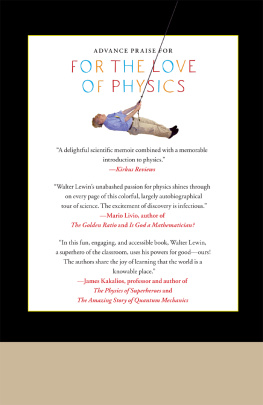All rights reserved.
Published in the United States by Crown, an imprint of the Crown Publishing Group, a division of Penguin Random House LLC, New York.
CROWN is a registered trademark and the Crown colophon is a trademark of Penguin Random House LLC.
Names: Kakalios, James, 1958 author.
Title: The physics of everyday things : the extraordinary science behind an ordinary day / James Kakalios.
Description: First edition. | New York : Crown Publishers, [2017] | Includes bibliographical references.
Identifiers: LCCN 2016046355 | ISBN 9780770437732 (hardcover) | ISBN 0770437737 (hardcover) | ISBN 9780770437749 (ebook) | ISBN 0770437745 (ebook)
Subjects: LCSH: PhysicsMiscellanea. | Science in popular culture.
Classification: LCC QC75 .K175 2017 | DDC 530dc23 LC record available at https://lccn.loc.gov/2016046355
CHAPTER ONE
You Begin Your Day
It is early morning, and youre asleep in bed. Your slow, regular breathing and steady pulse mark the passage of time, bringing you closer to when you must get up and begin your day. Today will be a busy one, with a visit to the doctor followed by a flight to another city for a business presentation. The vintage clock on your wall, a gift from your grandmother, provides a comforting tick, tock as the small bob hanging from the body swings rhythmically back and forth. Although the clock keeps good time, you rely on the alarm setting of your smartphone to wake you. But the first sensation that will register the start of your day will not be your hearing; it will be your sense of smell. Last night you set the digital timer on your coffeemaker to start its brewing cycle ten minutes before your phones alarm will go off. Your room soon fills with the aroma of fresh coffee, and you begin to stir.
T he elegant physics of an oscillating pendulum underlies the working of both the clock on the wall and the electronic timer on your coffeemaker, and plays a crucial role in many of the devices you will use as you prepare for the day.
A pendulum is a very simple device, consisting of a string, fixed at one end, with a mass, termed the bob, attached at the other end. The oscillations of the pendulum bob provide visual confirmation of one of the most important concepts in physics, that of the principle of conservation of energy: kinetic energy, the energy of motion, can only be converted to potential energy (the energy associated with a force acting on an object and the distance over which that force can cause motion) and vice versa. In a pendulum, you can increase the potential energy of the mass on the string by lifting it up, rotating the bob to a higher level while keeping the string taut, doing work against the gravity that pulls down on the bob. Once you release the bob, its potential energy is converted into kinetic energy as it moves in an arc of a semicircle. As the bob swings to the other side, the kinetic energy is converted back into potential energy. Both the starting height and the final height at the other end of the arc are the samewhen you release the mass and dont push it, it can never rise to a greater height than where it started.
A pendulum is useful for keeping time. The time it takes for the bob to complete a full cycle as it swings back and forth does not depend on how heavy the weight is, or on how high the mass is lifted to start it swinging (at least, for relatively small excursions back and forth). The greater the height of the mass, the larger the arc as it swings back and forth, and the larger the kinetic energy and speed it will have at the bottom of its arc. The longer distance and the faster speed exactly balance out, so that the time it takes to complete a cycle is the sameregardless of how high the bob is raised. The only factor that controls the time for a cycle is the length of the string. A pendulum whose string is just a little less than ten inches long will take one second to complete a full oscillation. As it swings, some of the kinetic energy of the bob is transferred to the surrounding air, pushing the molecules out of the bobs way. A careful audit will find that the gain in kinetic energy of the air is exactly equal to the reduction of the total energy of the pendulum, which is why mechanical clocksgrandfatherly and otherwiseneed periodic winding.
Its as true for the digital timer on the coffeemaker as it is for the mechanical pendulumto mark the passing of time, one needs a power supply (as everything, even counting seconds, requires a source of energy) and a way to convert that energy into a periodically varying cycle. The coffeemaker is plugged into an outlet connected to an external electric power grid. Conveniently for us, the mechanism by which electric power is generated at a power plant automatically leads to an electric current that oscillates back and forth like a pendulum that can be exploited when making a timer.
Your electric company rotates coils of wire between the poles of large electromagnets, and to see how that leads to an alternating electric current, lets return to the simple mechanical oscillating pendulum. Let the bob at the end of the string have an electric charge, say from a few extra electrons sitting on it. Even if this pendulum has a frictionless pivot point and is swinging in a perfect vacuum, with no air drag, it will eventually slow down and come to rest. Where did the bobs energy go? Into electromagnetic waves, demonstrating a profound symmetry between electric and magnetic fields that will be exploited repeatedly throughout your day.
An electric current is defined as the motion of electric charges moving together, and as the electrically charged bob swings back and forth, changing its speed, it is a constantly changing current. The current is large at the bottom of the arc, when the bob is moving at its fastest, and the current is zero at the top of the arc, when the bob is momentarily stationary. Moving electric charges, as in a current, generate a magnetic field (this is known as Amperes law); the faster they move, the larger the magnetic field. The swinging bob, creating a constantly changing current, generates an equally varying magnetic field. In turn, this changing magnetic field generates a varying electric field (known as Faradays law). This rhythmic oscillation of electric and magnetic fields is termed an electromagnetic wave, which will have the same frequency as that of the oscillating bob. These waves carry energy, and thus it takes energy to create them. This is why the oscillations of an electrically charged bob will slowly die out, as its energy of motion is converted into electromagnetic waves. We could see these electromagnetic waves with the naked eye if the pendulum were swinging back and forth very rapidly (say, a thousand trillion times a second), in which case these waves would appear as visible light.












